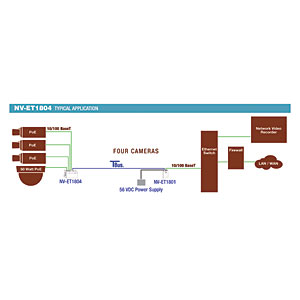
|
| The TBus product family provides a wide variety of IP and PoE+ connectivity options. |
When watching a football game, there is no more exciting play than when the losing team grabs victory with the last-ditch heave-ho pass that spans the field and results in the winning touchdown. In the alarm industry, the ability to connect devices over long distances has been a persistent problem that often results in tricky and costly installations that sometimes just do not work right — sort of like when the receiver drops the pass that would have clinched the game.
In the past, long-distance communications were generally either some type of wireless or fiber optic technology, which often required either extensive training for installation technicians or subcontracting of the communications link to another installation company. In either case, the net result often was a difficult and expensive installation, with the dealer dependent on these specialized technologies to carry the signals. If the technology creates problems after the initial installation is completed, the dealer may have to call in some experts to troubleshoot the communications link, which again is an expensive proposition.
One of the huge strengths of using IP-enabled devices is the multitude of products that are readily available to connect them onto local networks. After breaking the Ethernet over Coax barrier with its NV-EC1701 series of devices, NVT, Menlo Park, Calif., unleashed its latest product line, which really covers the field of IP communications over great distances of coax, UTP, and twisted pair cabling. NVT calls this technology TBus™ and its slogan is “any cable, any distance.” The NVT 1800 series of products is the alarm industry’s equivalent to pro football’s late, great, and hardly sedate Walter Payton of the Chicago Bears.
While Walter could run, block, and throw passes for touchdowns, the 1800 devices from NVT are also multifaceted and multi-talented. The first important feature is that each 1800 series transceiver can be utilized with all types of standard copper cabling including coax, UTP and twisted pair. This is a simple but critical issue that will reduce dealers’ cost of inventory, as specific devices for specific cable types are not needed; any 1800 device can do the job with most any cable type.
The second breakthrough is the cabling distances that can be achieved when using the TBus devices. According to their experiments, IP communications and PoE power transmission can be carried out to 3,000 meters, or 1.8 miles on RG-59 coax, while Cat5e UTP will provide the connectivity and power out to 700 meters, with twisted pair performance to 500 meters. This is truly breakthrough technology, as now there is a functional substitute for fiber optic links to cover long distances. While I am a true believer in fiber and have trained thousands of technicians in the beauty of fiber’s blinking lights, fiber work requires special tools, testers, and training that many dealers simply do not have available. By using the standard cable types that our industry’s technicians are already familiar with, installation and troubleshooting can be performed by today’s technicians equipped with standard tool sets.
TBus remote transceivers come in two types: a 1-port PoE+ (the NV-ET1801) and a 4-port version, the NV-ET1804. Each of these provides similar functions and cable connectivity options. A very valuable feature of the TBus transceivers is the incorporation of a “Link Quality” LED, which provides a visual indication (red/amber/green) of the network bandwidth that is available on a particular connection.
The above feature is a true breakthrough in the selling and installation of Ethernet over long distance coax/UTP/twisted pair cables. If existing cabling is to be reused for Ethernet and PoE+ purposes, testing of the cable can be rapidly performed. With a pair of the 1-port NV-ET1801s, a technician can quickly test whether the cable to be used is a viable Ethernet pathway. By connecting one transceiver at the far end, and connecting the other to the head-end along with the power supply, the Link Quality lights will tell the Ethernet connectivity story without having to connect any cameras, NVRs, or other network equipment.
Most any job that requires these long-distance transceivers will be an expensive installation, and smart dealers will use this critical test feature of the TBus devices to ensure that the existing cabling can support the devices that are to be connected. These tests would be best performed before the contract has been signed.
While the NV-ET1801s can be used to provide single-port to single-port Ethernet and PoE+ connections, NVT also has developed new transceivers that expand the capabilities of its TBus communications. There is a 4-port remote or head-end transceiver, the NV-ER1804, with each input port being capable of coax/UTP/twisted pair cable connections. Therefore, an installation could use two coaxes and two UTP cables, or any combination up to four cables. The 4-port transceivers can deliver an aggregate of 50 watts of PoE+ power to the remote devices, providing ample power for standard indoor IP cameras and other such devices.
Along with the 4-port TBus transceiver, NVT also has developed two larger rack-mount receivers, the NV-ER1808i (8 ports) and the NV-ER1816i (16 ports). These receivers provide all of the features of the 4-port unit with expanded port counts and the ability to increase the available PoE+ power. While the 8-port receiver comes equipped with a 125-watt PoE power supply, the 16-port version has a 250-watt power supply for high-wattage applications. By using these receivers, multiple IP security devices such as cameras, intercoms, and access control devices can be connected and powered using “any cable, any distance.”
All of the TBus products provide built-in 128-bit AES encryption that is activated automatically when the devices “enroll” with each other. The 4-port head-end receiver is equipped with a Gigabit RJ-45 female jack for uplink to the network, while its 8- and 16-port big brothers utilize SFP (small form-factor pluggable) ports that allow the usage of copper, multimode and single-mode fiber modules. If connected with the single-mode SFP transceiver, the “big brother” head-end receivers can communicate over 16 miles of fiber optic cable.
David Engebretson is the president of Slayton Solutions Ltd., Chicago, providing online and instructor-led training on fiber optics and networking electronic security systems. His latest book, Technician’s Guide to Physical Security Networking: Enterprise Solutions is a fully illustrated manual describing high-end IP physical security applications. Visit www.slaytonsolutionsltd.com for ordering information.




